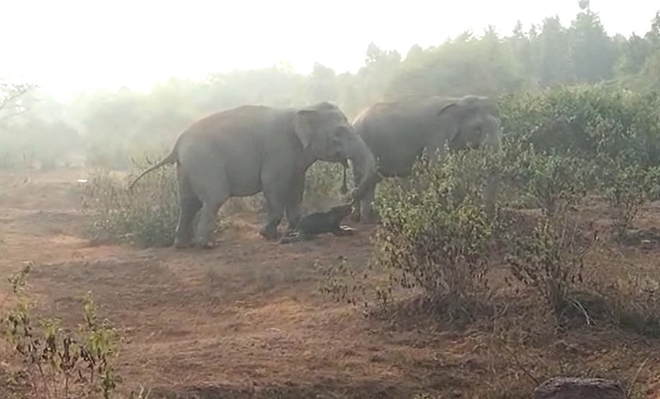GUWAHATI
Elephants in the eastern Himalayan floodplains bury their calves in a ‘legs upright’ position, a new study has found. Through long-term observation, the researchers also found that elephant herds tend to avoid the paths where the carcasses were buried and take parallel routes.
Rampant environmental changes and forest destruction push Asian elephants (Elephas maximus) and their African counterparts (Loxodonta africana) to explore human spaces to fulfil their dietary and ecological requirements, leading to ‘novel’ elephant behaviours in shared spaces.
While elephant calf burial is mentioned in African literature, it has hardly been documented in the Asian context. Parveen Kaswan, an Indian Forest Service officer posted in Alipurduar of West Bengal and Akashdeep Roy of the Indian Institute of Science Education and Research in Pune studied five such cases in the northern Bengal landscape.

Their study on “unearthing calf burials among Asian elephants” was published in the latest issue of the Journal of Threatened Taxa.
The study area covered fragmented forests, tea estates, agricultural lands, and military establishments in the vicinity of the Gorumara Wildlife Division and Buxa Tiger Reserve. It explains the burial strategy of elephants in the irrigation drains of the tea estates, which form the majority of the elephant corridors.
“We aimed to understand the peri-mortem strategy and post-mortem behaviour of the Asian elephants. The major findings reflect that the carcasses were carried by trunks and legs for a distance before being buried in a ‘legs upright’ position,” the study said.
Head prioritised
Marks on the bodies of the calves – the youngest weighing 160 kg was three or four months old while the oldest was about 12 months and weighed 350 kg – suggested the elephants dragged them from a distance to be buried at preferred locations.
The locations were irrigation drains of the tea estates where many elephants are born too, the study said.
The “strange” positioning of each carcass with the legs upright could be because one or more members of a herd needed a better grip to hold and lay the calf delicately in the trench.
“This strategic behaviour also reflects the care and affection of the herd member(s) towards the deceased. The behaviour suggests that in a situation of space crunch, the herd member(s) prioritise the head for the burial before the feet,” the study said.
Elephants occupy only 5% of their historic home range globally and India hosts more than 60% of the global Asian elephant population despite being one of the most populated countries on earth. About 78% of their current habitat lies outside protected areas in heterogenous landscapes, making them face more land-use challenges than other species due to their substantial dietary requirements and extensive home ranges.
Two of the five buried calves studied had poor nutrition while the dietary status of the other three was poor to normal.
Citing official data from 2017, the study said the four districts of northern Bengal — Darjeeling, Kalimpong, Jalpaiguri, and Alipurduar — host more than 500 elephants.







